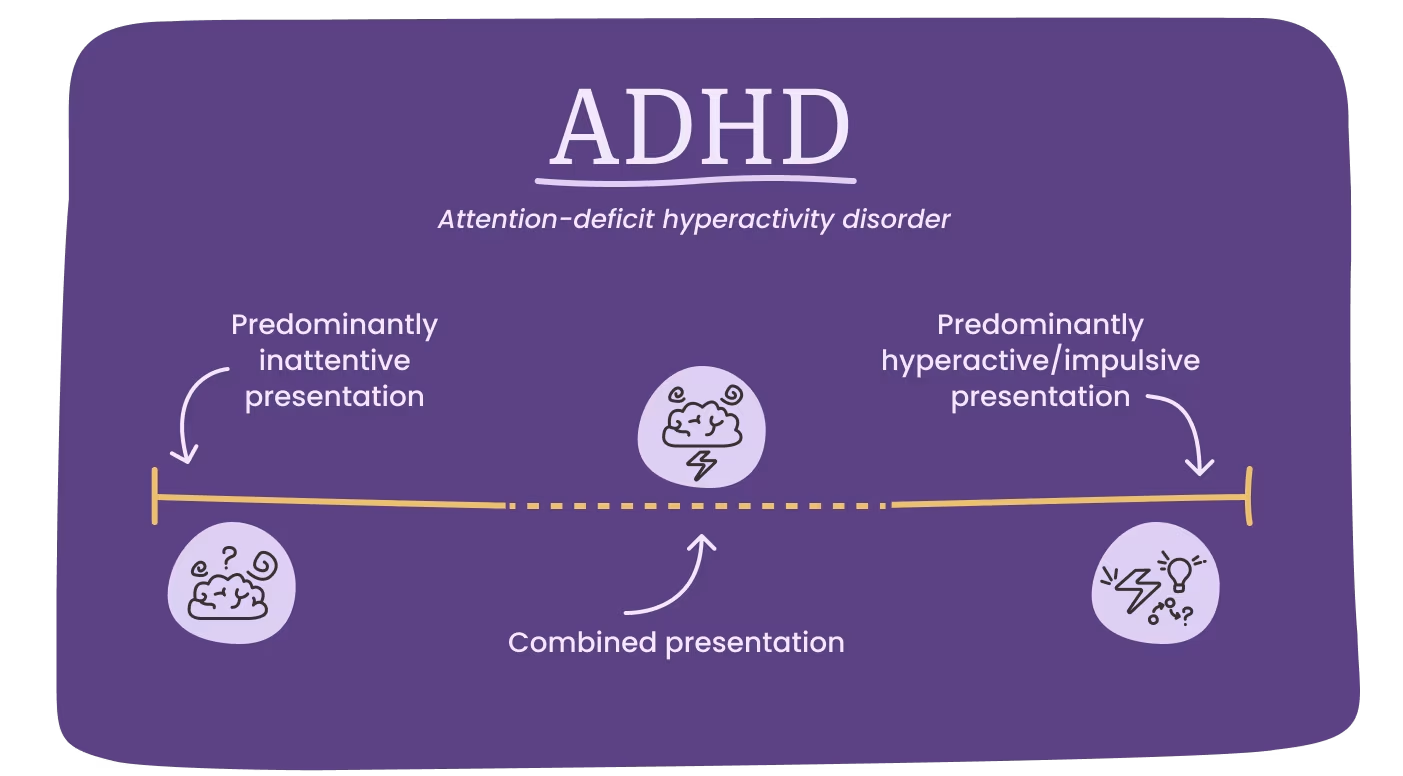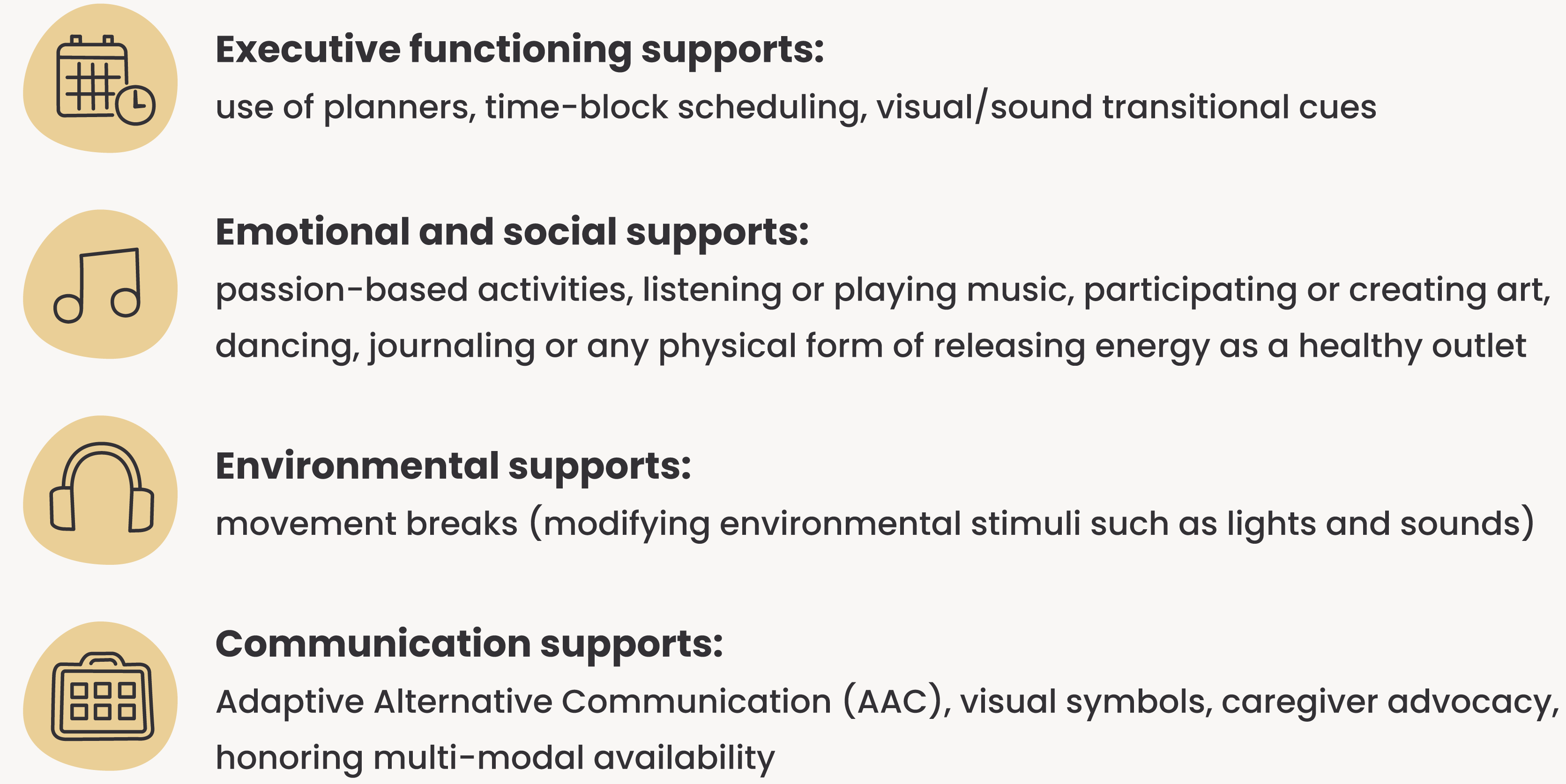AuDHD: What is it Like to Have Both ADHD and Autism?
To best understand AuDHD, it is important to recognize autism and ADHD as separate conditions, each with their own unique traits and challenges. This shows how the two neurodivergent profiles overlap and affect each other, creating a different and more complicated experience than having just one by itself.
What is ADHD?
According to the CDC, attention-deficit hyperactivity disorder, or ADHD, is one of the most common mental health conditions impacting children ages 3-17. ADHD is notoriously characterized by challenges with maintaining focus, staying still, interrupting others, and acting impulsively.
ADHD is classified into three categories or types, based on consistent symptoms that have been present for the past six months.
- Predominantly inattentive presentation: challenges staying focused or on task
- Common symptoms: difficulty maintaining attention, staying focused, following instructions, completing daily tasks, keeping engagement with others or maintaining organized
- Common symptoms: difficulty maintaining attention, staying focused, following instructions, completing daily tasks, keeping engagement with others or maintaining organized
- Predominantly hyperactive/impulsive presentation: excessive movement + actions taken without thinking through potential outcomes
- Common symptoms: fidgeting, having too much energy, difficulty sitting still, being overly talkative, interrupting others or difficulty waiting for their turn
- Common symptoms: fidgeting, having too much energy, difficulty sitting still, being overly talkative, interrupting others or difficulty waiting for their turn
- Combined presentation: blended behaviors from inattentive and hyperactive/impulsive criteria

How is ADHD different from autism?
ADHD and autism do have a handful of overlapping symptoms and can be easily confused with each other but they are not the same. The creation of the DMS-5 test in 2013 provided assessments for each which allowed individuals to receive a dual diagnosis. ADHD primarily impacts the brain’s capacity to maintain attention, concentration, and self-control. Children with ADHD typically seek out new opportunities but may have difficulty focusing, sitting still or controlling certain urges. These tendencies differ from autism where a child typically thrives off routine and structure. You can learn more about the basics of autism and the top signs and symptoms via our blog.

How are ADHD and autism similar?
Although symptoms differ per individual, in some circumstances, it can be a bit challenging to distinguish between the two conditions. Both are neurodevelopmental disorders that most often appear in children and impact day-to-day functionality based on brain development. This usually happens in areas like learning, communication, behavior, and emotional regulation. Common overlapping symptoms may include:
- Trouble paying attention or staying focused
- Stimming tendencies
- Finds it hard to plan, organize, or keep track of time
- May act impulsively
- Social challenges or not noticing social cues
- Sensory sensitivities, specifically to loud noises or certain textures
- Has strong emotional reactions in situations that are unfamiliar or uncomfortable
- Sleep struggles

Can someone have both ADHD and autism? What is AuDHD?
ADHD and autism can be present in the same individual, at the same time, which means they are co-occurring conditions. AuDHD is an informal term for having individual diagnoses of both ADHD and autism.
What causes AuDHD?
To date, the root cause of AuDHD is not clearly understood, even from a medical standpoint. Many believe that genetics contribute to the development of both ADHD and autism, therefore, it is generally assumed that AuDHD can be impacted by genetics.
What tests are available for autism and ADHD?
Since there is not an individual test for AuDHD, autism and ADHD must be assessed separately in detail. Each of the tests include specific tools used for each diagnosis. The Autism Diagnostic Observation Schedule (ADOS) and Childhood Autism Rating Scale (CARS) are the most common assessments for autism and the Conners 4 and Vanderbilt ADHD Diagnostic Rating Scale (VADRS)are typically used for ADHD. Each examination is conducted by a clinical doctor or pediatrician and may include a caregiver interview, developmental review of child history, review of family medical history and direct observation of child.
You can find more information about an autism assessment here.
When should someone get tested for ADHD if they have autism or vice versa?
Children with autism are more likely to also receive a diagnosis of ADHD compared to those without autism. Similarly, children and young adults with ADHD have a higher likelihood of being diagnosed with autism than those with only one condition. Since these conditions are currently evaluated separately but share overlapping symptoms, it can be helpful for many to be assessed for both, especially if a single diagnosis does not fully summarize an individual's experiences and symptoms. Overlapping traits can mask one another, so an accurate diagnosis may involve multiple professionals who require a thorough behavioral evaluation and detailed medical history for each diagnosis.
What treatment plans are best if you have AuDHD?
An integrated therapeutic approach is suggested for children who have AuDHD so that concerns and behaviors can be adequately addressed. Care plans most often include developmental autism therapy, paired with occupational therapy or behavioral therapy, depending on symptoms and severity.At Positive Development, our developmental model supports neurodivergent children by fostering trusting relationships through compassionate, gentle interactions. Developmental therapy builds on each child’s natural interest to play (or certain activities) as a meaningful way to communicate and connect, allowing therapeutic exercises to be practiced in an engaging and supportive manner through trusted connection. Learn more about our developmental model here.
How does someone manage having autism and ADHD?
Navigating both autism and ADHD demands significantly more mental energy than managing either condition by itself. This combination can propose unique challenges, such as heightened sensory sensitivities, impulsivity, increased difficulties with focus and attention, and more defined challenges in areas like emotional regulation and social interactions. Some children may benefit from prescribed medication partnered with therapeutic intervention.
The intersection of both diagnoses can lead to a unusual experience that is different from having only one. To support this, the balance between predictability and novelty (providing safety while also allowing for individualized and natural stimulation) is crucial. A variety of supports should be included to help prevent feelings of being overwhelmed, a common symptom in young children. These supports should be taught in collaboration with a trusted caregiver, ensuring the process takes place in a safe and supportive environment, such as a child’s home or therapy clinic. Emphasizing independence within these supports encourages individuals to actively participate and maintain control over their own care. Typical forms of support include:

What resources are available for those with AuDHD?
There are many organizations that offer helpful information on supporting autistic individuals who have ADHD as well as resources for deepening general autism knowledge:
- Positive Development: Provides parent-focused educational information about autism, development therapy, and how to navigate a neurodivergent household with respect and honor.
- Neuroclastic: Amplifies autistic voices and stories while advocating a neurodiversity-affirming world.
- The Autistic Self-Advocacy Network: Provides educational information about autism and advocates for autistic-affirming policy changes.
- ADDitude Mag: Shares medically accurate and community-based information about ADHD.
- CHADD: Focuses on information and community support for people with ADHD and loved ones.
Positive Development is available to answer any questions you might have. Feel free to contact us at (833) 587-1784 or via email at hello@positivedevelopment.com.






